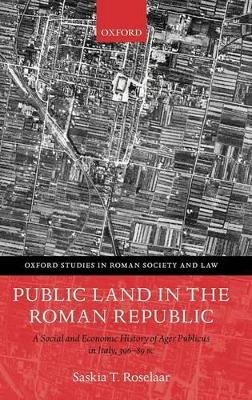
Public Land in the Roman Republic
A Social and Economic History of Ager Publicus in Italy, 396-89 BC
Seiten
2010
Oxford University Press (Verlag)
978-0-19-957723-1 (ISBN)
Oxford University Press (Verlag)
978-0-19-957723-1 (ISBN)
In the first volume in this new series on Roman society and law, Saskia T. Roselaar traces the social and economic history of the ager publicus, or public land, identifying the developments in Roman economy and demography which led to a gradual process of privatization.
In the first volume in this new series on Roman society and law, Saskia T. Roselaar traces the social and economic history of the ager publicus, or public land. As the Romans conquered Italy during the fourth to first centuries BC, they usually took land away from their defeated enemies and declared this to be the property of the Roman state. This land could be distributed to Roman citizens, but it could also remain in the hands of the state, in which case it was available for general public use. However, in the third and second centuries BC growth in the population of Italy led to an increased demand for land among both commercial producers and small farmers. This in turn led to the gradual privatization of the state-owned land, as those who held it wanted to safeguard their rights to it. Roselaar traces the currents in Roman economy and demography which led to these developments.
In the first volume in this new series on Roman society and law, Saskia T. Roselaar traces the social and economic history of the ager publicus, or public land. As the Romans conquered Italy during the fourth to first centuries BC, they usually took land away from their defeated enemies and declared this to be the property of the Roman state. This land could be distributed to Roman citizens, but it could also remain in the hands of the state, in which case it was available for general public use. However, in the third and second centuries BC growth in the population of Italy led to an increased demand for land among both commercial producers and small farmers. This in turn led to the gradual privatization of the state-owned land, as those who held it wanted to safeguard their rights to it. Roselaar traces the currents in Roman economy and demography which led to these developments.
Saskia Roselaar is Newton International Research Fellow, University of Manchester and The Royal Society.
1. Introduction ; 2. Ager publicus from the regal period to 133 ; 3. The legal conditions of ager publicus ; 4. The second century and the economy of ager publicus ; 5. The Gracchi and the privatization of ager publicus ; 6. General conclusion
| Erscheint lt. Verlag | 22.7.2010 |
|---|---|
| Reihe/Serie | Oxford Studies in Roman Society & Law |
| Zusatzinfo | 15 in-text illustrations |
| Verlagsort | Oxford |
| Sprache | englisch |
| Maße | 162 x 238 mm |
| Gewicht | 782 g |
| Themenwelt | Geschichte ► Allgemeine Geschichte ► Vor- und Frühgeschichte |
| Geschichte ► Allgemeine Geschichte ► Altertum / Antike | |
| Recht / Steuern ► Allgemeines / Lexika | |
| Recht / Steuern ► EU / Internationales Recht | |
| Recht / Steuern ► Rechtsgeschichte | |
| Wirtschaft ► Betriebswirtschaft / Management ► Rechnungswesen / Bilanzen | |
| Betriebswirtschaft / Management ► Spezielle Betriebswirtschaftslehre ► Immobilienwirtschaft | |
| ISBN-10 | 0-19-957723-4 / 0199577234 |
| ISBN-13 | 978-0-19-957723-1 / 9780199577231 |
| Zustand | Neuware |
| Haben Sie eine Frage zum Produkt? |
Mehr entdecken
aus dem Bereich
aus dem Bereich
auf den Spuren der frühen Zivilisationen
Buch | Hardcover (2023)
C.H.Beck (Verlag)
CHF 27,95
Konzepte – Methoden – Theorien
Buch | Softcover (2024)
UTB (Verlag)
CHF 55,85
Was Pompeji über uns erzählt
Buch | Hardcover (2023)
Propyläen (Verlag)
CHF 44,75


